This CE Center article is no longer eligible for receiving credits.
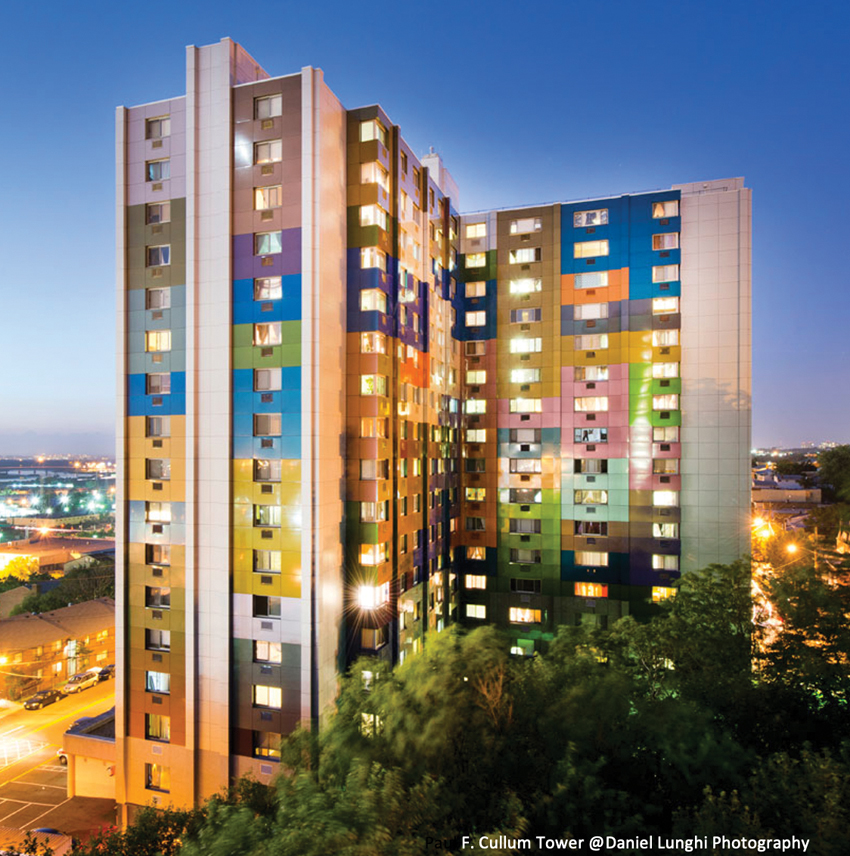
Photo courtesy of Daniel Lunghi Photography/ALUCOBOND
At the Paul F. Cullum Tower in North Bergen, N.J., metal composite material cladding offers a flame-retardant, colorful facade.
Commenting on the significance of these additions, Keith Nelson, NCARB, AIA, CDT, BCXP, principal, department manager, ECS Mid-Atlantic, Richmond says, “The changes made in the 2019 version of NFPA 285 are significant and will have an impact on the industry and the use of this standard in design and construction projects.”
He explains that system joints are often the most vulnerable component of a wall assembly. Whereas NFPA 285’s former testing protocols did not include joint location requirements, the updated version requires that the joint is located above the centerline of the window.
“At least one vertical joint must run the entire height of the assembly and at least one horizontal joint must run the entire width of the assembly,” explains Gerald Schultz, P.E., The FPI Consortium Inc., Woodridge, Illinois. “These changes attempted to address the weakest point of a wall assembly.”
As opposed to only testing a surface-burning fire, by testing the assembly with joints in these locations, the potential impact of the fire on the cavity behind the exterior cladding is more severe, and a truer reflection of the system’s ability to withstand fire propagation.
In addition, Ray Grill, P.E., Ray Grill Consulting, PLLC, Clifton, Virginia, explains that as opposed to the previous NFPA version that was only applicable to exterior wall assemblies required to be noncombustible, NFPA 285-19 also applies to exterior wall assemblies for all types of construction that exceed 40 feet in height.
The actual changes were made to enhance life safety in buildings and to make testing amongst manufacturers more uniform. While NFPA 285-19 won’t become an enforceable standard until municipalities adopt the 2021 IBC, as good stewards believing that it is the right thing to do, many manufacturers have already tested their products to ensure compliance with NFPA 285-19 requirements.

Image courtesy of the Metal Construction Association
To pass the NFPA 285 two-story test, the fire cannot propagate more than 10 feet above the window opening and the horizontal spread cannot be more than 5 feet from the centerline of the window.
The NFPA 285 Test
FPA 285-19 is an assembly test for exterior walls that contain combustible components or materials. The test determines vertical and horizontal flame spread by simulating an interior flashover fire that impacts the exterior cladding through a compromised window opening. It’s important to stress the fact that NFPA 285 is a large-scale assembly test.
“The test is a two-story test to examine the potential for fire spread… the entire assembly needs to be considered and can have an impact on performance,” explains Grill.
This means that individual products and systems cannot pass the test individually. Materials are only considered acceptable when evaluated in conjunction with the entire wall assembly.
The testing evaluates an assembly under the conditions of a post-flashover fire originating inside a building. Flashover is a dangerous phenomenon in fire behavior, as the heat energy of a fire radiates to all the contents of an enclosed area, eventually causing them to reach ignition temperature. Flashover is the moment of full-room involvement when all the combustible contents in the space autoignite simultaneously.
By simulating the worst-case scenario, the new 2019 requirements more accurately reflect how an assembly could perform in a “worst case” construction in the event of a fire. In particular, by locating the vertical joint in the test sample at the center of the window opening, the joint is exposed to the flame plume coming from both the burn room and external burner. “Locating the horizontal joint within 3 feet of the window header also exposes it to the flames emanating from the window opening,” adds Andy Williams, P.E., director of codes and standards, Metal Construction Association.
In terms of the actual test apparatus, the apparatus is built with a two-story structure that is 18 feet high, with test rooms on each story that measure 10 feet wide and 10 feet deep, with a minimum floor-to-ceiling height of 7 feet. The test specimen completely closes the burn rooms of the test structure, except for a 20-inch-by-78-inch window opening on the first story.
In order to pass the test, the assembly must show that the vertical fire will not progress more than 10 feet above the window opening and that horizontal spread is not more than 5 feet from the centerline of the window.
To simulate a fire, one gas-fired burner is located in the interior of the first-level burn room and a second moveable burner is located on the exterior by the window header. First, the interior burner is ignited, followed by the window burner five minutes later. The burners alternately increase in fuel load every five minutes. After 30 minutes, both burners are shut off.
Whereas wood was traditionally used as the fire source in the original full-scale, multistory test, gas is now utilized to produce a more consistent heat source. In addition, the window in the testing apparatus does not include glass. In simulating the fire, it is assumed that the glass would have already broken out.
Ultimately, the NFPA 285 test is very difficult to pass. Consequently, assemblies which do pass the test offer a high level of assurance for the fire protection and safety of building occupants.
In order to pass this rigorous test, the following conditions must be met:
- Vertical flames are not visually observed on the exterior wall 10 feet or higher above the window opening header.
- The thermocouples at 10 feet vertically from the window opening do not exceed 1,000°F.
- Flames are not visually observed on the exterior wall horizontally 5 feet or further from the center of the opening.
- The thermocouples at 5 feet horizontally from the window opening do not exceed 1,000°F.
- Temperature rise does not exceed 500°F within the second-story test room, measured 1 inch from the interior wall assembly surface.
- Smoke and flame cannot visually be observed within the second-story test room.
- Regarding the wall cavity, temperature rise cannot exceed 1,000°F within any wall cavity air space.
- Temperature rise does not exceed 750°F within any combustible wall components more than ¼-inch thick.
The demand for high-performance, durable, aesthetically pleasing, and energy-efficient buildings has led to building envelope designs that incorporate combustible materials such as cladding, insulation, and weather-resistant barriers.
Charged with protecting the public health and safety of building occupants and providing safeguards from hazards associated with the built environment, the International Building Code (IBC) mandates all building systems and materials meet prescribed requirements and undergo relevant testing. The IBC outlines the minimum requirements to protect the public health and safety of building occupants, while avoiding both unnecessary costs and preferential treatment of specific materials or methods of construction. A large portion of the code deals with fire prevention and mitigating fire risk.
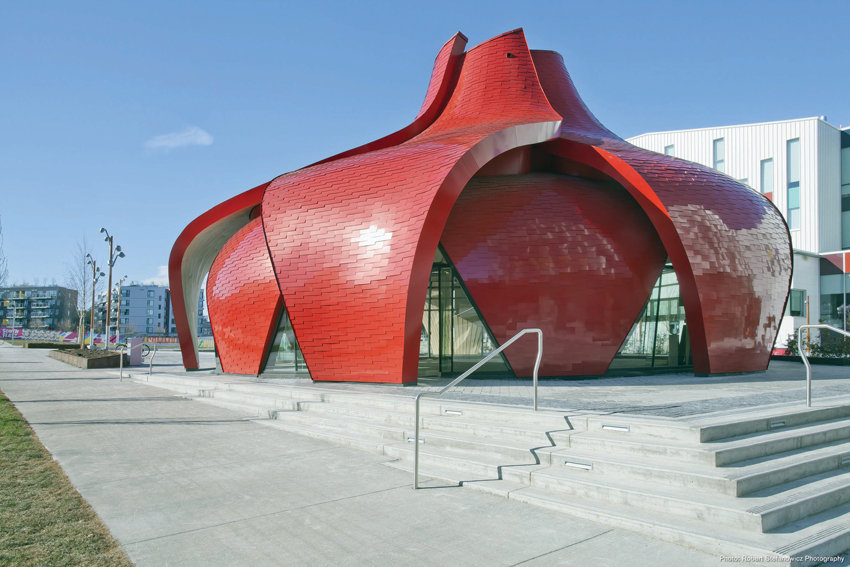
Photo courtesy of Robert Stefanowicz Photography/3A Composites
The metal composite cladding on the BNW Pavilion, located adjacent to the Emily Carr University of Art + Design in Vancouver, helped the structure meet updated fire propagation test protocols.
For wall assemblies in particular, systems containing combustible materials must be tested and demonstrate a certain level of resistance to fire spreading. An intermediate-scale fire test, National Fire Protection Association (NFPA) 285 is the Standard Fire Test Method for Evaluation of Fire Propagation Characteristics of Exterior Non-Load-Bearing Wall Assemblies Containing Combustible Components. NFPA 285 is a code-required standard and a key component of exterior wall design testing.
In order to help eliminate some of the complexity and confusion surrounding these designs, in addition to knowing when an NFPA 285 test is required, it is helpful for architects and specifiers to better understand the impact of material choices in the metal composite material (MCM) wall assembly.
For starters, the IBC does not define noncombustible or combustible. This terminology is defined by the NFPA in the Life Safety Code as follows: noncombustible is a material that cannot ignite or burn, cannot support combustion, and cannot release flammable vapors. Examples include brick, stone, steel, and mineral wool. All other materials are considered combustible. Product examples include phenolic panels, HPL, MCM , foam plastic insulation, and fiberglass insulation, and are tested per the American Society for Testing and Materials ASTM E136 standard test method.
It’s important to understand that many common products—e.g., desks, blinds, wood, plastic, most furniture, and flooring are combustible—but not all combustible items have the same burning characteristics.
For example, when evaluating the combustible characteristics of MCM, it’s important to differentiate between the different types of materials sandwiched in between the metal. The main options are a fire-retardant (FR) core and “standard” polyethylene (PE), which is a thermoplastic product.
The FR core utilizes the addition of minerals, such as alumina trihyrdrate or magnesium oxide, that effectively break down when subjected to extreme heat. This releases water vapor, helps suppress the fire, and causes the material to self-extinguish once the flame source is removed.
On the contrary, PE’s solid plastic core serves as a continuous fuel source enabling flames to spread vertically up the wall assembly. Standard core MCM (PE) does not pass NFPA requirements and has been identified as a significant source in multiple building fires.
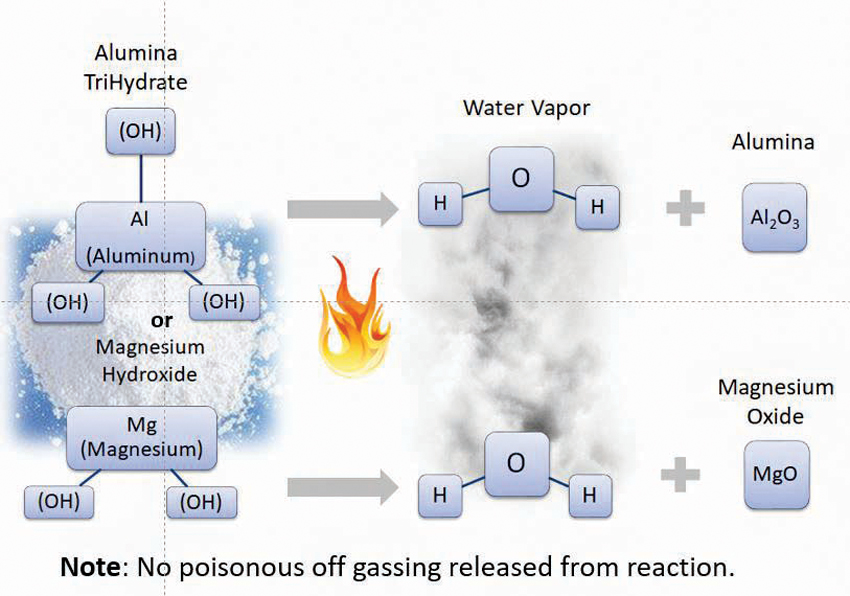
Image courtesy of the Metal Construction Association
The flame-retardant core in a metal composite material panel incorporates alumina trihyrdrate or magnesium oxide, which breaks down when exposed to extreme heat. This releases water vapor and helps suppress the fire.
High-Rise Fire Events
In 2017, the tragic London Grenfell Tower fire ultimately took the lives of 72 people, with more than 70 others injured. Exacerbated by the absence of sprinkler systems and fire egress routes, what started as a malfunctioning fridge-freezer on the building’s fourth floor was fueled by plastic insulation and aluminum composite rainscreen cladding with a PE core. Unbroken air space in the building enclosure resulted in the chimney effect accelerating flame spread. To make matters worse, residents had propped open the stairwells, further accelerating flame spread.
As related by Daniel A. Martin, P.E., CFEI, CVFI, a fire protection engineer with Jensen Hughes, in a recent METALCONLive! webinar entitled “Cladding Safety in Light of Global Fires,” construction details that contributed to the Grenfell fire included multiple types of exterior insulation such as polyiso and phenolic, MCM sheets with a PE core containing no FR additives, cavity barriers not in place or continuous around window openings where required by code, and exterior wall geometrics creating large air gaps behind the MCM panels.
This tragic perfect storm enabled the fire to spread significantly in a short period of time. According to the NFPA 285, an acceptable wall assembly requires the fire to spread less than 10 feet from the window opening within 30 minutes.
Becauses MCMs with a PE core are unable to pass the NFPA 285 test, this had effectively banned their use in the U.S. for high-rise construction, or on panel installations higher than 40 feet.
Prior to the Grenfell Fire, however, their use was permitted in the U.K. MCM could bypass similar full-scale tests as long as the wall assembly components, when tested individually, passed small-scale combustibility tests. In contrast, NFPA 285 stipulates that individual assembly components must be tested as whole system.
A number of significant fires have also occurred in Dubai, most notably the Marina Torch fire in 2015 and the Tamweel Tower in 2012. At the time, the Marina Torch, 79 stories high, was one of the tallest residential buildings in the world. Started by a barbecue grill on the 51st-floor balcony, a total of 101 apartments were damaged as the fire extended up 28 stories to the top of the building.
The latter fire was started by a discarded cigarette butt that fell on a pile of waste, eventually reaching the aluminum composite panel cladding. The fire lasted five and a half hours, spread to the interior residential units, and falling/burning debris caused a number of cars parked below to catch fire. In the aftermath of the Tamweel Tower, Dubai banned the use of MCM panels with a PE core.
Pointing out the danger of fires reaching the point of flame propagation in a white paper entitled Building Exterior Wall Assembly Flammability: Have We Forgotten the Past 40 Years?, fire protection engineer John Valiulis, P.E., technical director of the nonprofit International Firestop Council, states that falling/burning debris can interfere with, or even prevent, firefighters' access to a burning building. “It can damage or destroy firefighting equipment… it can block, or make very hazardous, the egress path for occupants trying to escape from the building.”
In comparison to these European and Middle Eastern fires, it’s important to note that North America has had no catastrophic fires due to stringent and successful IBC code requirements. While there was a major fire in Las Vegas attributed to Exterior Insulation and Finish System (EIFS) cladding, and one in New Jersey fueled by panels with a PE core, both fires were of low consequence with no injuries, and occurred more than 15 years ago.
In a September 2017 NFPA Journal article, Angelo Verzoni writes, “The absence of severe exterior wall assembly fires in the U.S. seems like a testament to the successes of North American codes and standards like NFPA 285.”
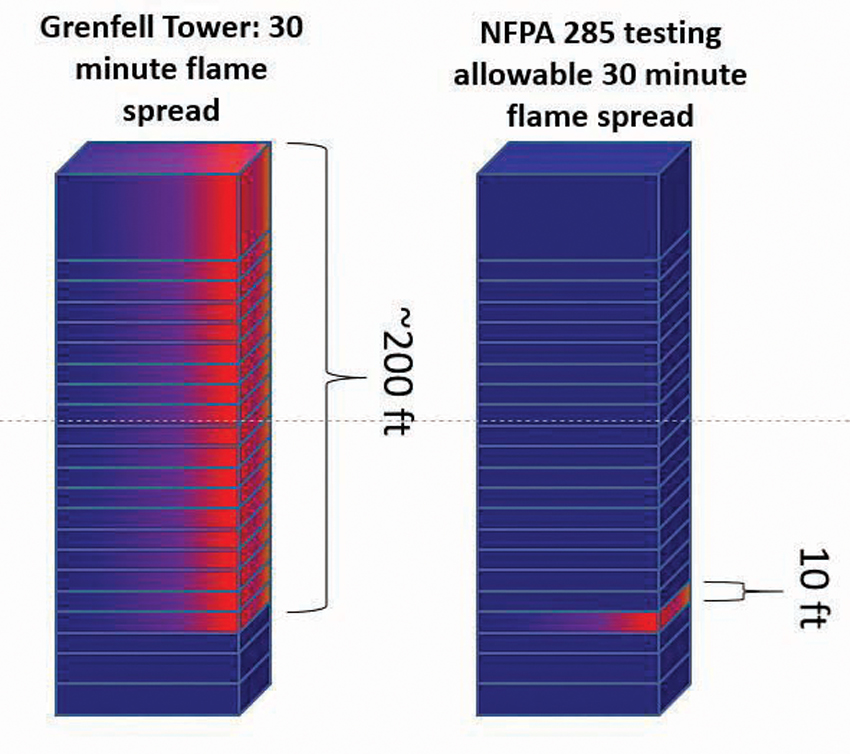
Image courtesy of the Metal Construction Association
In the London Grenfell Tower fire, the fire spread approximately 200 feet within 30 minutes. To pass the NFPA 285 test, a fire cannot spread more than 10 feet from the window opening within the same period of time.
The Evolution of NFPA 285
Giving a little background on the prelude to NFPA 285’s development, the energy crisis of the 1970s led to increased exterior insulation applications. By the end of the decade, the Society of Plastics Industry developed a full-scale fire test. Then, in 1988, the Uniform Building Code adopted UBC 17-6, the Method of Test for the Evaluation of Flammability Characteristics of Exterior, Nonload-bearing Wall Panel Assemblies Using Foam Plastic Insulation. In the early 90s, further testing, and the desire to have better control for the test, led to a reduced, intermediate-scale test, which then led to an updated UBC 26-9, adopted in 1997. One year later, in 1998, the NFPA adopted UBC 26-9 as NFPA 285.
As early as the inaugural version of the IBC (2000), NFPA 285 testing was required for aluminum composite material (ACM), insulated metal panels (IMP), and foam plastic insulation (Section 2603.5) used as a component in exterior cladding assemblies (chapters 14 and 26) for Types I through IV construction. In 2009, the IBC expanded NFPA 285 testing to include Section 1408 - EIFS and Section 2612 - fiber-reinforced polymer (FRP) systems. Then in 2012, water-resistant barriers (WRB) were added in Section 1403.5, as well as high-pressure laminate panels in Section 1409.
Offering some perspective, Valiulis stated, “The fire protection engineering community in the U.S. foresaw the increasing use of combustible components in exterior wall construction decades ago. The test method, which today is titled NFPA 285... has resulted in an existing building stock with exterior walls that have exhibited a resistance to self-propagating fires.”
In NFPA 285’s latest 2019 version, a number of important changes were made, making the flame propagation testing protocols more comprehensive. These new additions include:
- Inclusion of some Types V construction
- Joint layout requirements for exterior veneer: requiring a vertical joint within 12 inches of the centerline of the window for testing exterior veneer panels with the exception of EIFS, stucco, and brick
- Requiring a vertical joint between 12 and 35 inches above the top of the window for testing exterior veneer panels with the exception of EIFS, stucco, and brick
- The specification of window header, jamb, and sill construction for the test
- Allowing wood studs for the test wall. This is relevant to alternate systems allowing inclusion of fire-retardant treated lumber, which is allowed in Type III construction in tested assemblies.

Photo courtesy of Daniel Lunghi Photography/ALUCOBOND
At the Paul F. Cullum Tower in North Bergen, N.J., metal composite material cladding offers a flame-retardant, colorful facade.
Commenting on the significance of these additions, Keith Nelson, NCARB, AIA, CDT, BCXP, principal, department manager, ECS Mid-Atlantic, Richmond says, “The changes made in the 2019 version of NFPA 285 are significant and will have an impact on the industry and the use of this standard in design and construction projects.”
He explains that system joints are often the most vulnerable component of a wall assembly. Whereas NFPA 285’s former testing protocols did not include joint location requirements, the updated version requires that the joint is located above the centerline of the window.
“At least one vertical joint must run the entire height of the assembly and at least one horizontal joint must run the entire width of the assembly,” explains Gerald Schultz, P.E., The FPI Consortium Inc., Woodridge, Illinois. “These changes attempted to address the weakest point of a wall assembly.”
As opposed to only testing a surface-burning fire, by testing the assembly with joints in these locations, the potential impact of the fire on the cavity behind the exterior cladding is more severe, and a truer reflection of the system’s ability to withstand fire propagation.
In addition, Ray Grill, P.E., Ray Grill Consulting, PLLC, Clifton, Virginia, explains that as opposed to the previous NFPA version that was only applicable to exterior wall assemblies required to be noncombustible, NFPA 285-19 also applies to exterior wall assemblies for all types of construction that exceed 40 feet in height.
The actual changes were made to enhance life safety in buildings and to make testing amongst manufacturers more uniform. While NFPA 285-19 won’t become an enforceable standard until municipalities adopt the 2021 IBC, as good stewards believing that it is the right thing to do, many manufacturers have already tested their products to ensure compliance with NFPA 285-19 requirements.

Image courtesy of the Metal Construction Association
To pass the NFPA 285 two-story test, the fire cannot propagate more than 10 feet above the window opening and the horizontal spread cannot be more than 5 feet from the centerline of the window.
The NFPA 285 Test
FPA 285-19 is an assembly test for exterior walls that contain combustible components or materials. The test determines vertical and horizontal flame spread by simulating an interior flashover fire that impacts the exterior cladding through a compromised window opening. It’s important to stress the fact that NFPA 285 is a large-scale assembly test.
“The test is a two-story test to examine the potential for fire spread… the entire assembly needs to be considered and can have an impact on performance,” explains Grill.
This means that individual products and systems cannot pass the test individually. Materials are only considered acceptable when evaluated in conjunction with the entire wall assembly.
The testing evaluates an assembly under the conditions of a post-flashover fire originating inside a building. Flashover is a dangerous phenomenon in fire behavior, as the heat energy of a fire radiates to all the contents of an enclosed area, eventually causing them to reach ignition temperature. Flashover is the moment of full-room involvement when all the combustible contents in the space autoignite simultaneously.
By simulating the worst-case scenario, the new 2019 requirements more accurately reflect how an assembly could perform in a “worst case” construction in the event of a fire. In particular, by locating the vertical joint in the test sample at the center of the window opening, the joint is exposed to the flame plume coming from both the burn room and external burner. “Locating the horizontal joint within 3 feet of the window header also exposes it to the flames emanating from the window opening,” adds Andy Williams, P.E., director of codes and standards, Metal Construction Association.
In terms of the actual test apparatus, the apparatus is built with a two-story structure that is 18 feet high, with test rooms on each story that measure 10 feet wide and 10 feet deep, with a minimum floor-to-ceiling height of 7 feet. The test specimen completely closes the burn rooms of the test structure, except for a 20-inch-by-78-inch window opening on the first story.
In order to pass the test, the assembly must show that the vertical fire will not progress more than 10 feet above the window opening and that horizontal spread is not more than 5 feet from the centerline of the window.
To simulate a fire, one gas-fired burner is located in the interior of the first-level burn room and a second moveable burner is located on the exterior by the window header. First, the interior burner is ignited, followed by the window burner five minutes later. The burners alternately increase in fuel load every five minutes. After 30 minutes, both burners are shut off.
Whereas wood was traditionally used as the fire source in the original full-scale, multistory test, gas is now utilized to produce a more consistent heat source. In addition, the window in the testing apparatus does not include glass. In simulating the fire, it is assumed that the glass would have already broken out.
Ultimately, the NFPA 285 test is very difficult to pass. Consequently, assemblies which do pass the test offer a high level of assurance for the fire protection and safety of building occupants.
In order to pass this rigorous test, the following conditions must be met:
- Vertical flames are not visually observed on the exterior wall 10 feet or higher above the window opening header.
- The thermocouples at 10 feet vertically from the window opening do not exceed 1,000°F.
- Flames are not visually observed on the exterior wall horizontally 5 feet or further from the center of the opening.
- The thermocouples at 5 feet horizontally from the window opening do not exceed 1,000°F.
- Temperature rise does not exceed 500°F within the second-story test room, measured 1 inch from the interior wall assembly surface.
- Smoke and flame cannot visually be observed within the second-story test room.
- Regarding the wall cavity, temperature rise cannot exceed 1,000°F within any wall cavity air space.
- Temperature rise does not exceed 750°F within any combustible wall components more than ¼-inch thick.
It’s important to note that the 10-foot vertical heat spread is actually 4 feet because the flames emitting from the window opening due to the gas fire inside the burn room extend 5 to 6 feet above the window opening without the involvement of any combustible materials contained within the wall assembly.
Importance of the Panel Joints And Their Location
A great deal of information has been provided about panel joinery and the required location for the horizontal and vertical panel joint. But why is this so critical in MCM panel assembly?
A technical joint in an MCM system is ½-inch wide. The joint is typically manufactured by closing off the edge of the panel either by folding the MCM at a 90° angle upon itself or by attaching a perimeter extrusion to the MCM panel. Both methods use a faster anchorage system to attach the panel to the substructure. The overall appearance of the ½-inch joint may be one of several different types. While each type of joint provides a different appearance, each joint allows for the fastening of the panel to the substrate and for expansion of the MCM panels subjected to dramatic temperature change.
Probably the simplest panel joint is known as a “wet seal.” The ½-inch gap between panels is still the backer rod and some type of sealant material—in many cases a structural silicone—that provides a smooth finish to the panel and resists the penetration of rainwater.

Photo courtesy of CEI Materials
At the NASA Langley Laboratory in Hampton, Va., aluminum composite material in two distinct finishes serve as flame-retardant rainscreen cladding and helps create a modern look for the aeronautic building.
The other common alternative is an “open joint” or rainscreen joinery system. In this instance, both air and water are allowed to enter the cavity behind the panel and drain out as needed. Often times there will be some type of cover plate or spline plate that will be inserted into this joint to cover the attachment system. While these spline plates provide a desirable appearance, they are not necessarily intended to stop the flow of air and water to the cavity behind them.
Not only do air and water penetrate the exterior cladding layer at the system joinery, it is also considered to be the weakest location in a fire situation. This is the reason for the specific location of the specified vertical and horizontal joint location above the window opening. When the fire exits the window opening, it reattaches to the panel system in the general area where both the vertical and horizontal joint exist. In some cases, the fire has direct access to the cavity behind the cladding which will typically contain insulation. The joinery's direct exposure to the fire, and the fact that the fire is now hidden from view, are important concepts.
Also, the joint depth, and the depth of cavity behind the exterior cladding, is often dictated by the panel attachment system. The details and dimensions of this cavity are important because if the combustible elements of the wall assembly ignite, flame spread through that cavity could go undetected for some time and could progress up the wall assembly.
The NFPA 285 test is designed not only to measure the flame spread up the exterior side of the exterior cladding; it is also designed to measure the flame spread that takes place within the cavity between the interior face of the exterior cladding and the exterior sheathing. Any elements within this cavity that are combustible must also meet the performance criteria required for the entire wall assembly.
So, the panel joints provide potential access to the internal wall assembly elements without the benefit of protection from the exterior cladding, which in the case of MCM, consists of a metal surface that reflects the flames and heat for a period of time.
Composite Materials with a Flame-retardant Core
In terms of why MCMs with an FR core perform well when subjected to NFPA’s increased stringencies, it is helpful to understand how the material is manufactured. First, an extruded core material is produced and then a metal coil is applied. These two components are bonded together through the controlled application of heat, pressure, and tension. Next, the bonded sheet is cooled in a controlled process to maintain the bond integrity and flatness.
When exposed to fire, the metal skins initially deflect the heat and fire away from the combustible core of the panel. While the metal skins will eventually melt, the material remains in place, and the metal limits both the amount of combustible core available to the fire and the spread of flame.
Also of note is the fact that wall cavity heat gain is not typically an issue in MCM systems in the absence of exterior flames. In other words, the wall does not self-sustain the flame after burners are turned off. Thanks to its FR core, the wall self-extinguishes almost immediately.
In addition to a certain level of flame retardancy, the metal skin provides structural stability for the panel and can be finished in a number of colors and finish types. Incidentally, the IBC requires a minimum thickness of 0.019 inches as a weather covering to resist normal exposure without significant visual damage.
Weather-Resistive Barriers
As noted, all combustible components in combination must be considered when determining if a wall assembly meets NFPA requirements. In addition to combustible cladding material, this includes certain types of WRBs and insulation.
WRB product options vary by their application method and base chemistry. The chemistry and required thickness of combustible weather barriers contribute to the product’s level of fire performance.
WRBs come in different types: fluid-applied, self-adhering sheets, or mechanically fastened sheets. In general, the fluid-applied WRBs are more difficult to control in thickness and have the potential to provide more combustible fuel than the sheet goods. Consequently, when the WRB exceeds the peak heat release of 150 KW/m2, and the WRB is the only combustible in the wall assembly, then an NFPA 285 test is required.
Bituminous coatings, which are rubberized asphalts, are fluid-applied weather- and air-barrier products. Typical applications are thick, up to 100 mils or more, and have been associated with problems including cracking, wrinkling, blistering, and melting. More significant is the fact that asphalt-based membranes tend to exceed the 150 KW/m2 threshold and can perform poorly in the NFPA 285 flammability test.
It should be noted that spray-applied weather-barrier applications may not provide a controlled thickness, as is the case with premanufactured sheet goods. This could mean varying amounts of combustible materials on the wall. Also, the difference between a mechanically attached (i.e., staple- or cap nail-applied) and an adhesively applied weather barrier can introduce additional combustibles in the form of the adhesive material.
In his experience, Nelson relates, “The following WRBs generally contribute minimally to fire propagation and can provide robust performance: silicone fluid-applied, STPe fluid-applied, and commercial grade spun-bonded polyolefin. These are all recommended to comply with ASTM E2357, though it’s important to follow their manufacturer’s high-performance recommendations.”
The fact that the WRB can be specified in various locations (i.e., behind, or in front of, the insulation, and in some cases, both), and that each orientation can affect the fire performance of the wall assembly differently, underscores the importance of testing the wall as a full assembly, per NFPA 285 requirements.
The specific combustible limits of WRBs, when it is the only combustible in the wall assembly, are detailed in Chapter 14 of the IBC and determine where NFPA 285 is required. In addition, architects and engineers can better understand fire performance, and which products have successfully passed NFPA 285, by reviewing test reports, certification reports, and/or engineering judgments.
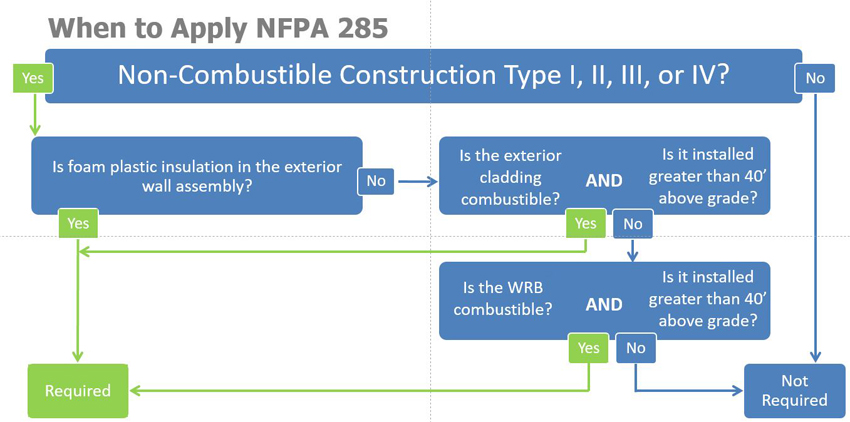
Image courtesy of Metal Construction Association
By applying a number of questions, project teams can determine if their exterior wall design requires an NFPA 285 test.
Insulation
On the topic of exterior insulation, Nelson explains that hygrothermal and thermal performance push increased insulation values to the exterior of the wall assembly as “ci,” or continuous exterior insulation.
At the same time, it’s important to be aware that all insulation is not created equal. In rating product types from worst to best, based on performance when exposed to fire, exterior insulation types rate as follows: spray polyurethane foam (SPF) open-cell, expanded polystyrene (EPS), extruded polystyrene (XPS), SPF closed-cell, polyisocyanurate (ISO), and mineral fiber.
Mineral wool insulations are a good choice, but if this is the only product specified, in order to confirm that a particular product is up to par, specifiers should request ASTM E136 test results from the mineral wall manufacturer.
In general, from a fire-protection perspective, XPS and EPS will not meet the requirements of NFPA 285 when used with aluminum composite materials. As is the case with WRBs, fire performance varies by chemistry type and by manufacturer, so specifiers should refer to individual manufacturers for specific fire performance information, in addition to test reports, certification reports, and/or engineering judgments.
With regards to how NFPA 285 and weather barriers currently tie into the IBC, testing is required for wall assemblies that exceed 40 feet in height, with some exceptions. One exception can be made if:
- Walls in which the WRB is the only combustible component and the exterior wall has a covering of brick, concrete, stone, terracotta, stucco, or steel, with minimum thicknesses in accordance with Table 1405.2 in the IBC
- WRB is the only combustible component in the wall and meets combustibility thresholds.
In addition, windows and doors, and flashing for windows and doors, are considered to be part of a water-resistive barrier for purposes of this section in the code. Consequently, WRBs trigger a review for NFPA 285 compliance, per chapter 14, when used with another combustible material in the wall assembly. At the same time, certain WRBs do not require NFPA 285 on buildings over 40 feet tall if they are the only combustible product in the wall assembly.
If the WRB is the only combustible component in the wall, it must meet the following performance criteria, per ASTM E1354, “Standard Test Method for Heat and Visible Smoke Release Rates for Materials and Products Using an Oxygen Consumption Calorimeter,” to qualify for an NFPA 285 testing exception:
- When tested at 50 kW/m2, the peak heat release rate must be less than 150 kW/m2
- The total heat release must be less than 20 MJ/m2
- The effective heat of combustion must be less than 18 MJ/kg
Per ASTM E84, the flame-spread index must be ≤ 25 and the smoke developed index must be ≤ 450. NFPA 285 testing is required of wall assemblies containing plastic insulation (EPS, XPS, ISO) at any height with the exception of single-story buildings complying with Section 2603.4.1.4 of the IBC. This exception is intended for cold storage buildings. Also, insulated metal panels (IMPs) containing foam plastic insulation are governed by chapter 26 of the IBC.
Section 2603.5 of the 2018 IBC references “Exterior Walls of Buildings of any Height.” Because foam plastic insulation is combustible, compliance with NFPA 285 needs to be demonstrated in accordance with 2603.5.5. Furthermore, the exception requires that the insulation not exceed 4 inches in thickness and it must be covered by aluminum or steel. The minimum base metal thickness for the aluminum is 0.016 inches. An MCM facing of 0.019 inches meets this criterion. Authorities Having Jurisdiction (AHJ) have at times, however, negated MCM because its core does not fit the definition of a “foam plastic” core in 2603.
To summarize, the following conditions will create an NFPA 285 trigger, and therefore require that the wall assembly pass the test for flame propagation allowance before the assembly is recognized as meeting the performance requirements of the code.
- Combustible claddings taller than 40 feet
- Noncombustible and combustible claddings with plastic insulation for buildings of any height (with the single-story exception discussed above)
- Noncombustible claddings, measuring more than 40 feet in height, if used with certain combustible WRBs
In addition to NFPA 285 requirements, as previously noted, MCM cladding is also subject to meeting a number of other standards. This includes a Class A Rating, which can be achieved by showing a flame-spread index of less than, or equal to, 25, and a smoke-developed index less than, or equal to, 450, per ASTM E84. The MCM must also be separated from the interior by a thermal barrier, typically gypsum.
IBC Product Labeling
Per the IBC 1406.14, MCM panels must be tested, inspected, and labeled. Per the IBC 1703.5, an approved testing agency must be utilized to test a representative sample of the MCM to relevant IBC code test standards, to maintain a record of the testing performed, provide sufficient detail to verify compliance with the test standard, and periodically perform an inspection of the in-plant manufacturing.
These third-party inspections maintain a level of quality by ensuring that what architects are specifying has been verified by an independent third party. This third party will evaluate the performance of the MCM. There are several labs that test the MCM and MCM systems. While the IBC does not require such an evaluation, it is highly recommended for quality assurance.
As an example, the International Code Council Evaluation Services Evaluation Services (ICC-ES) Report program provides a level of confidence to end-users by ensuring that the right tests in the IBC have been performed. In addition, ICC-ES has developed an Acceptance Criteria for MCM manufacturers. ICC-ES also ascertains that a third-party inspection program exists, ensuring that the MCM manufacturer continues to make a product of the same production quality. This is accomplished by monitoring the production of that material and the quality standards of the facility producing it.
An ICC-ES Evaluation Report includes the following:
- Data on the product report holder and a description of the building product and its intended uses
- The code(s) that were used to evaluate the product and a brief description of the product's properties
- Installation instructions that identify requirements to help the inspector ensure the product is installed properly in compliance with the tested assemblies.
- List of data (i.e., test reports, calculations, installation instructions) that were used in evaluating the product
- Information to help identify the product in the field
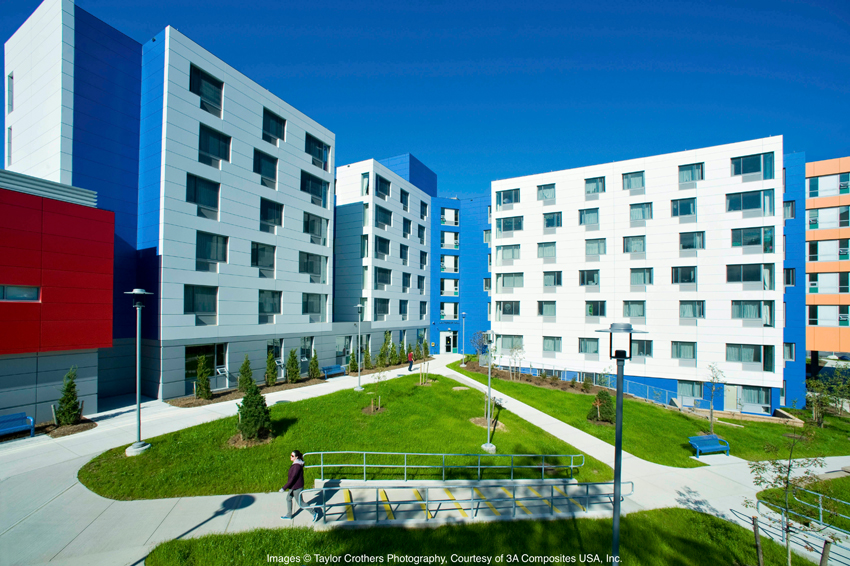
Photo courtesy of Taylor Crothers/3A Composites USA
Prefabricated aluminum composite material in bold colors deliver a striking facade at Stony Brook University’s Nobel Halls in Stony Brook, N.Y.
Engineering Analysis
With the combinations of components and materials making up a wall assembly numbering in the thousands, it is literally impossible to test every single assembly. Furthermore, building teams may have a need to change one of the materials in an already-tested assembly. Consequently, Engineering Judgements (EJ), also called Engineering Evaluations, can be performed in lieu of NFPA 285 testing.
“Engineering Judgements are a fantastic tool to gain minor variations in an NFPA 285-compliant assembly and still comply with the intent of the building code,” states Nelson. “Any deviation from the tested assembly in the materials used, their configuration, how the materials are attached, the size of the air space, no longer comply with NFPA 285. An EJ will allow a project team to swap out the WRB, insulation, or other materials of the assembly, provided that the rest of the assembly remains the same and is subjected to small-scale testing to demonstrate that the new material does not contribute to fire propagation more than the original material.”
IBC Section 104.11 allows EJ submittal where the AHJ can consider alternate materials, designs or methods of construction.
Performed by a qualified professional, the EJ analyzes the proposed assembly with the expectation that it will meet fire protection standards based upon the following:
- Previous successful NFPA 285 tests of "similar" wall assemblies
- Additional material tests such as the cone calorimeter test, which provides ignition and heat-release rate information for various materials
- Previous experience in the testing of wall assemblies to NFPA 285.
“The Engineering Judgment should use engineering principles, such as heat transfer, to evaluate the difference in order to render an engineering opinion regarding the performance of the non-tested assembly,” explains Grill.
Often, EJs are provided in the form of an engineering analysis table/product specific evaluation that presents a menu of different components (i.e., a listing of different weather barriers, exterior insulation types, air cavity depths, and cladding materials) that, in combination, could be used to create a “fire-protection friendly” wall assembly. Regarding the air cavity, the EJ can only allow a depth equal to, or less than, that which was tested.
While these analyses present the information to determine the acceptability of a wall assembly, it is ultimately up to the AHJ to review the evaluation and rule on acceptability.
Experts recommend starting the process in the early stages of design, with a list of the proposed exterior wall materials and wall cross-sections. The team should also reach out to manufacturers for their NFPA 285 history and compare this list with the proposed wall assembly.
Another variable driving interest in EJs is the fact that NFPA 285 wall assembly tests cost an average of $35,000 to $40,000 and take two to four months of planning, product inspections, fabrication, and assembly. The manufacturer also takes responsibility for shipping the material to the lab, preparing the drawings for the test specimen, and having the assembly installed. Furthermore, the test itself, the report, and the disposal, must all be paid for.
While manufacturers must pay an engineer to perform an EJ, and there’s no guarantee that the AHJ will ultimately accept the assembly, it can be a more viable option, particularly when a building is already under construction and there simply isn’t time to organize and perform the NFPA 285 test.
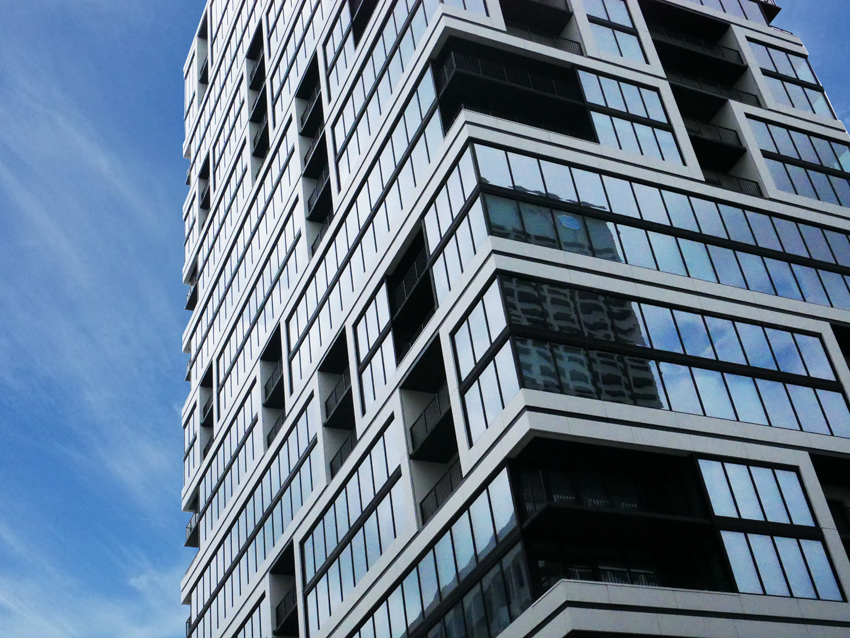
Photo courtesy of MillerClapperton
Metal composite material helps create the l’s and i’s of the lilli Midtown high-end apartment tower in Atlanta.
As Intended
Once an assembly passes the NFPA 285-19 test, and it comes time to install the wall, Schultz stresses the importance of verifying that the products ordered match the products in the approved design and that the assemblies are installed in the same way as they were tested. This includes specifications like stud spacing, fastener lengths, and air gap dimensions.
In review, U.S. building codes have been incorporating multistory fire testing since the 1980s. The development and IBC adoption of NFPA 285 provides life safety for buildings and is required for wall assemblies containing combustible components—weather-resistant barriers, insulation, and cladding—in Building Types I-IV. With changes made to NFPA 285-19, the life safety of wall assemblies has been further enhanced.
It should be emphasized that NFPA 285 is a wall assembly test, not a material test. In lieu of NFPA 285 testing, engineering analyses based upon manufacturers' tests can provide specifiers with more NFPA 285-compliant options for wall assemblies. As noted, a key NFPA 285-19-friendly option for architects are MCM panels with an FR core, as they contain fire-retardant chemicals that limit the amount of available fuel and potential for flame spread.
As more MCM systems are tested against–and meet–the stricter NFPA 285-19 standards, engineers anticipate that this will spur a rise in demand for this cladding option as a solid and safe choice.
Barbara Horwitz-Bennett is a veteran architectural journalist who has written hundreds of CEUs and articles for various AEC publications.BHBennett.com









